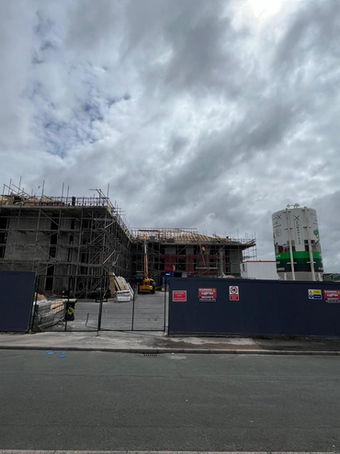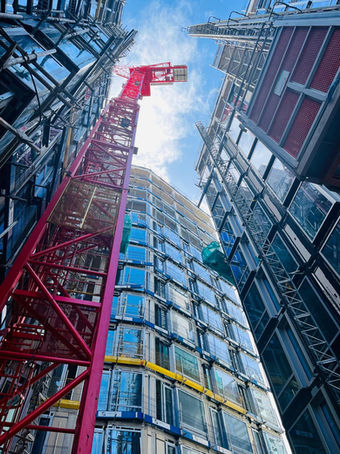Fire safety innovations and legislation have drastically reduced damage and injuries in modern buildings, thanks to the mandatory installation of fire sprinkler systems.
However, historic buildings often remain vulnerable due to the absence of these modern protections. According to the National Fire Chiefs Council (NFCC), fire sprinklers control over 99% of incidents when activated, highlighting the critical need for these systems in all types of structures, particularly those of historical significance.
Historic buildings preserve cultural heritage and provide a window into our past. These beloved structures often feature unique architectural details and significant historical value, but they also face increased fire risks due to flammable building materials, ageing electrical systems and the absence of modern fire protection systems. Retrofitting these buildings with fire sprinklers is crucial for conserving our heritage and preventing the loss of these irreplaceable structures.
At Base Fire Sprinklers, we understand the delicate balance between preserving historical aesthetics and implementing effective fire safety measures. With over 30 years of experience and cutting-edge technology, our team employs innovative solutions to integrate fire sprinkler systems discreetly. We utilise concealed sprinkler heads and strategically place piping to minimise visual impact, ensuring that the building's historical features remain intact while providing essential fire protection.




Contact us today.
If you’re looking for a fire sprinkler system installation company to help you navigate the challenges of retrofitting a system into a historical building, trust Base Fire Sprinklers. We ensure compliance with regulations while preserving your cultural heritage.
Call now on 0800 009 6906.
What types of fire protection systems can be installed in heritage buildings?
Numerous fire protection systems are suitable for installation in historic buildings, including smoke detectors, fire alarms, fire extinguishers and sprinkler systems.
Among these, fire sprinkler systems are one of the most efficient methods to protect heritage buildings against fire damage. These systems consist of a network of pipes filled with water strategically installed throughout the building. In the event of a fire, the sprinkler system automatically activates, releasing water to control and extinguish the flames. This immediate response can significantly reduce the potential for extensive damage and preserve the historical integrity of the building.


I would like to compliment the engineers that we have met on site who have completed the servicing and repair works on the systems....I cannot find one area where I would be unhappy with the service we have received.
Jack Newell, Weaver Vale Housing Trust
What are some of the challenges of retrofitting fire sprinklers in heritage buildings?
Sustaining the architecture
Whilst new construction requires that fire sprinkler systems are in the initial design and build plan and perfectly complement the structure they’re part of, retrofitting historic buildings often presents unique challenges. Older buildings will demand design or layout changes to ensure smooth fire sprinkler system installation. For instance, a building might have delicate, historic features that need strengthening to accommodate a sprinkler system’s weight, or it may not have enough water to activate the fire sprinkler system, requiring additional water storage tanks and booster pumps.
Many heritage buildings hold architectural significance, requiring careful installation to preserve their structural integrity and aesthetics; this often demands creative and discreet solutions for integrating fire sprinklers. For instance, concealed sprinkler heads and paint coatings that match the existing interior elements can provide an inconspicuous and cohesive appearance.
Permits and regulations
Strict regulations and codes make the retrofitting process even more complex—legally, building codes must be strictly followed, and special permits may be necessary for historic buildings. So, not only must you maintain the building’s character, but you must also balance these requirements, which can be tricky. Successful collaboration between architects, preservationists, engineers and fire safety experts is crucial for successful installation.
It is also important to understand that regulatory issues can arise from older structures which may not adhere to the most recent fire safety codes. Familiarisation with the local construction ordinances is highly recommended before moving forward with the fire sprinkler installation process to maintain rigorous compliance and thorough protection.
Electrical upgrades
The building’s existing electrical circuitry may need upgrades to ensure optimal compatibility and functionality with the different fire sprinkler attachments. As such, it is essential to check for compliance with alarm systems, fire pump motors and other electrical parts associated with the fire sprinkler system.
Original or outdated wiring systems in older buildings were not designed to handle modern electrical loads, making them one of the most common fire hazards. These systems can easily become overloaded, leading to shorts and electrical fires. Therefore, it is essential to inspect and upgrade existing electrical systems to ensure they are compatible with current usage and meet modern safety standards.

Planning for the installation process
Installing fire sprinklers inside historic buildings is a complex process involving numerous steps. It will require careful attention regarding factors not present in new construction. The below steps can help to establish a comprehensive, robust and secure fire safety plan:
-
Carefully evaluate the building: Inspect the structural integrity, electrical wiring and other features to ensure accessible installation and check for obstructions or hazards that could affect performance.
-
Ensure access to a usable water supply: Check water source availability, water pressure and internal plumbing to determine whether the structure can accommodate installation or if a new water supply is required.
-
Maintain compliance with regulations: Meticulously review the building’s existing layout and specifications to ensure the details of your installation plan adhere to all relevant fire protection legislation.
-
Make necessary design adaptations: Analyse aesthetic and structural features, reconfiguring the layout if needed. Eliminate any fire hazards and obstructions, maximising occupant safety and preserving architectural and historic significance.
-
Choose the most practical model: Assess the building’s specific needs, fire risks and structural requirements to ensure the most practical sprinkler model. Wet lines are typically preferable for older buildings due to their simple, reliable functionality.
-
Use dedicated precision during installation: When installing your system, place valves, pipes and sprinkler heads throughout the interior following spacing requirements. The system requires regular inspections during installation to ensure optimal function whilst preventing corrosion.
Despite the challenges, installing fire sprinklers in historic buildings offers significant benefits. A properly fitted and functional sprinkler system greatly reduces the risk of fire-related damage, helping preserve the physical structure and its irreplaceable treasures. Additionally, it enhances overall safety for occupants, visitors and surrounding properties, ensuring a secure environment for everyone.













